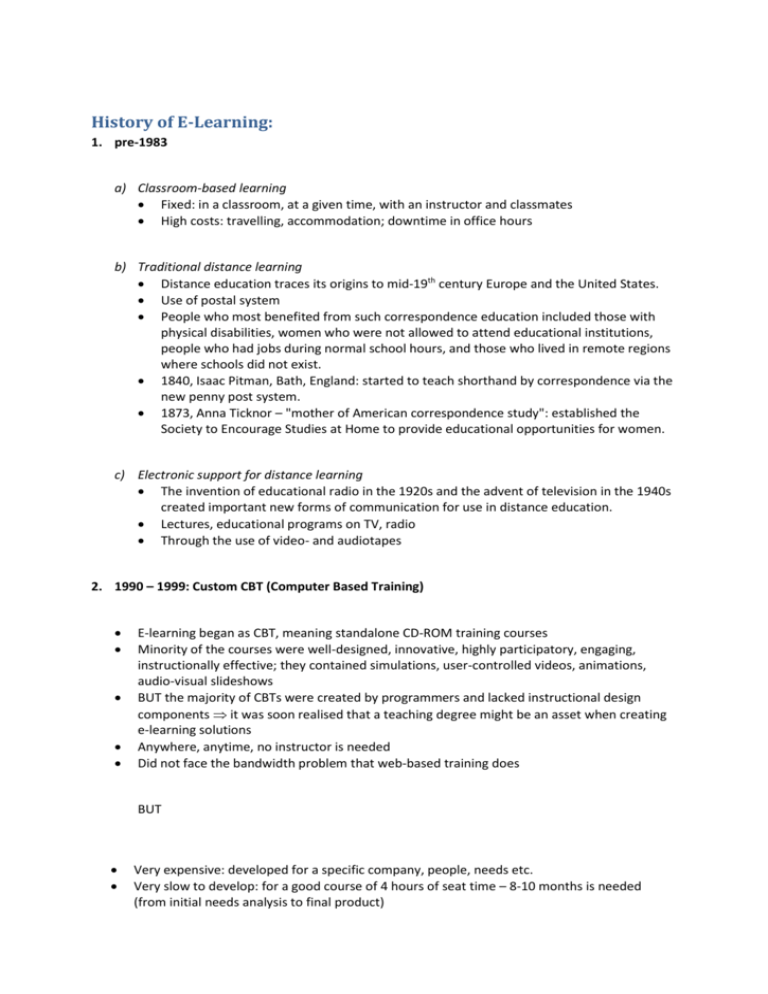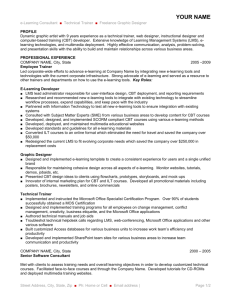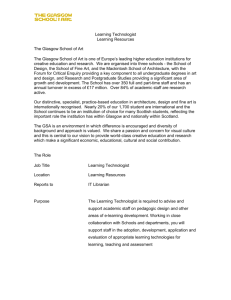History of E-Learning
advertisement

History of E-Learning: 1. pre-1983 a) Classroom-based learning Fixed: in a classroom, at a given time, with an instructor and classmates High costs: travelling, accommodation; downtime in office hours b) Traditional distance learning Distance education traces its origins to mid-19th century Europe and the United States. Use of postal system People who most benefited from such correspondence education included those with physical disabilities, women who were not allowed to attend educational institutions, people who had jobs during normal school hours, and those who lived in remote regions where schools did not exist. 1840, Isaac Pitman, Bath, England: started to teach shorthand by correspondence via the new penny post system. 1873, Anna Ticknor – "mother of American correspondence study": established the Society to Encourage Studies at Home to provide educational opportunities for women. c) Electronic support for distance learning The invention of educational radio in the 1920s and the advent of television in the 1940s created important new forms of communication for use in distance education. Lectures, educational programs on TV, radio Through the use of video- and audiotapes 2. 1990 – 1999: Custom CBT (Computer Based Training) E-learning began as CBT, meaning standalone CD-ROM training courses Minority of the courses were well-designed, innovative, highly participatory, engaging, instructionally effective; they contained simulations, user-controlled videos, animations, audio-visual slideshows BUT the majority of CBTs were created by programmers and lacked instructional design components it was soon realised that a teaching degree might be an asset when creating e-learning solutions Anywhere, anytime, no instructor is needed Did not face the bandwidth problem that web-based training does BUT Very expensive: developed for a specific company, people, needs etc. Very slow to develop: for a good course of 4 hours of seat time – 8-10 months is needed (from initial needs analysis to final product) Static, Monolithic: too difficult and expensive to modify (update) once they were finished and deployed – authoring tools were programming languages, and the resulting courses were unique software programmes. it becomes quickly obsolete Impossible for organisations to track user's performance 3. 1994 – 1999: Packaged CBT pre-packaging CBT training courses and selling them on a mass scale (no customisation) They typically provided IT skills training and some desktop-computing skills training It is more cost effective that custom CBT and packaged IT training courses can be quite effective BUT Business/professional skills have to be industry/business specific and customisable for these custom CBT is better even if it costs more 4. The rise of the Learning Management System (LMS) Customers realised that they had significant numbers of high-cost, high-promise CD-ROM courses going out to all sorts of location, but no one knew whether they were really used and what impact they had A new feature appeared: student administration and data reporting system Automates the administration of CD-ROM based (and even Webbased) training Launches and tracks CBT courses Reports on the results (how many people used and for how long, result of the tests etc.) Learning Management System: attempt to administer, manage, track and report on skills, classroom training and CBT across the enterprise + helps to form learner communities (via the use of chats, forums, e-mail etc.) BUT it needs strict standards so that different content sources readily plug-and-play on any administrative technology platform (LMS) 5. 1999 – everyone moves to the Web, WBT 1999 is a breakout year for advances both in content and technology related to e-learning Internet appears in the 80s and starts to spread in the early 90s: CBT WBT (Web-based training) Most of the e-learning companies moved to Web technologies as quickly as possible. Basic drivers for this transition: Web-based training helped to justify the cost of the Internet Learning could be taken anywhere anytime (No CD-ROMs are needed to be distributed and stored, updated etc.) The life of the course can be easily extended, content can easily be modified and updated – it must be implemented once on a server (the training workstations do not need to be updated one by one) Central LMS management and control via easy-to-establish Web connections enables training across the enterprise But there were downsides of WBT as well: Limited engineering technologies for Web-server based courses shot down much of the interactive and instructional richness compared to CD-ROM courses. Bandwidth continued to be a problem, server latency, network congestion Wait times interrupted the learning experience. 6. The present Technological advances (Java/IP network applications, high-bandwidth access) are revolutionising the training industry: high-quality, interactive, effective courses with simulations, live ILT via the Web etc. LMSs became the data-management backbone of e-learning, "making e-learning happen". Theoretical background – Constructivism Another factor that affected e-learning during the 1990s was the growing interest in constructivism. According to Constructivism, learners are required to a) b) c) d) solve complex and realistic problems (e.g. simulations) work together to solve those problems (e.g. live e-learning) examine the problems from multiple perspectives take ownership of the learning process (e-learning allows the learner more control over his/her learning experience – you can do it anytime, anywhere, at your own pace, choose what you need, choose the depth of the course etc.) e) become aware of their own role in the knowledge construction process Instruction is becoming more learner-centred, non-linear and self-directed. Student's responsibility is emphasised. Learning happens via meaningful experiences and direct encounters.







